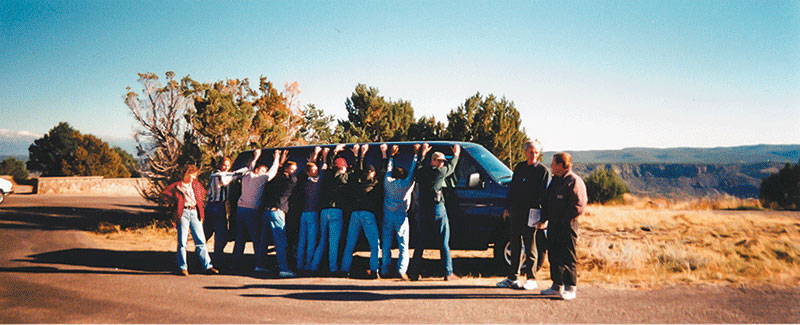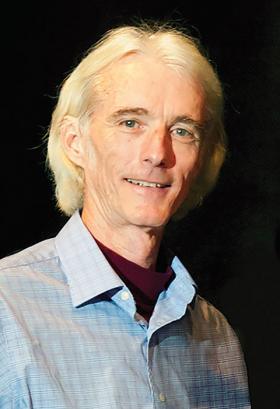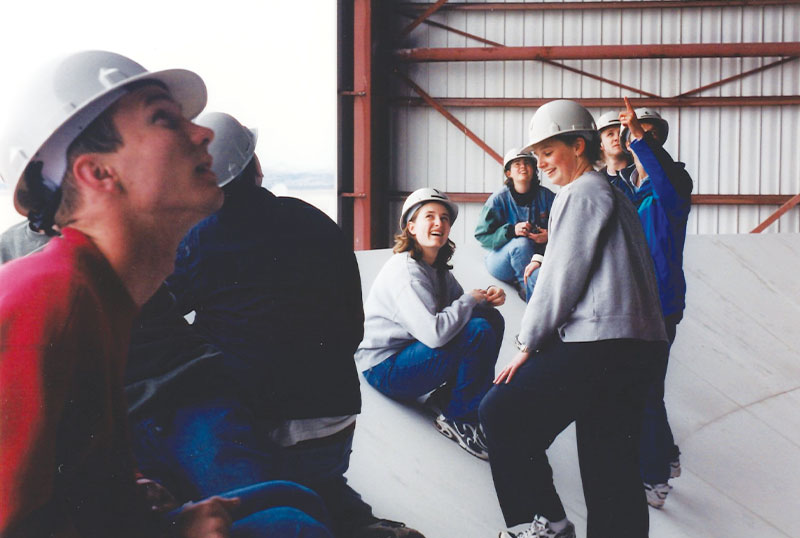The Trip of a Lifetime
Winter
2020
Singularities - Profiles in Physics
The Trip of a Lifetime
Kendra Redmond, Editor
 “I was given a bundle of unopened mail from the SPS National Office and told, ‘If you want to be the SPS advisor here, the job is yours,’” recalls Dwight E. (a.k.a Ed) Neuenschwander, the physics department chair at Southern Nazarene University (SNU) in Oklahoma. The year was 1987, and Neuenschwander was SNU’s newest physics professor. He’s been receiving the SPS mail ever since, with the exception of a two-year leave of absence in the mid-1990s to manage the education division of the American Institute of Physics and SPS.
“I was given a bundle of unopened mail from the SPS National Office and told, ‘If you want to be the SPS advisor here, the job is yours,’” recalls Dwight E. (a.k.a Ed) Neuenschwander, the physics department chair at Southern Nazarene University (SNU) in Oklahoma. The year was 1987, and Neuenschwander was SNU’s newest physics professor. He’s been receiving the SPS mail ever since, with the exception of a two-year leave of absence in the mid-1990s to manage the education division of the American Institute of Physics and SPS.
Like many great stories, Neuenschwander’s SPS advisor tale starts with a road trip. In the fall of ’87, Kansas State University was hosting a zone meeting, so Neuenschwander and several physics students piled into a van and drove 300 miles each way for their first SPS outing. On the long ride home they discussed the research talks given by undergraduates from other schools. When he heard the students say, “We can do that!” Neuenschwander was thrilled. “To cut a long story short, after attending two more zone meetings as spectators, we were giving talks of our own,” he says.
Trips are a key part of the SPS experience at SNU—trips to meetings and conferences, trips to local schools to lead outreach events, and trips to interesting scientific sites. “In the past 15 years or so we have taken field trips to NASA in Houston, twice to Fermilab and Chicago museums, and every other year to New Mexico to visit the Very Large Array, Trinity Site, the Atomic Energy Museum, Los Alamos, and other sights in New Mexico’s interesting landscape,” Neuenschwander says.
The excursions are good professional development opportunities for students, but the van rides are just as important. “That is where we get to know each other as people, talk about life, share our stories and experiences. Those experiences build personal relationships,” Neuenschwander says. “Such relationships are the glue that holds any community together.”
 While advising students at SNU, Neuenschwander has supported, challenged, and encouraged thousands of SPS students and alumni at other institutions during his 25 years of service on the SPS National Council, as the editor of SPS publications for many years, and as author of more than 150 articles in the SPS Observer and Radiations magazines, including the “Elegant Connections in Physics” column. His thought-provoking articles tackle the relations between physics concepts, research results, science history, maintaining mental health amid the stress of studying physics, ethics, and social responsibility.
While advising students at SNU, Neuenschwander has supported, challenged, and encouraged thousands of SPS students and alumni at other institutions during his 25 years of service on the SPS National Council, as the editor of SPS publications for many years, and as author of more than 150 articles in the SPS Observer and Radiations magazines, including the “Elegant Connections in Physics” column. His thought-provoking articles tackle the relations between physics concepts, research results, science history, maintaining mental health amid the stress of studying physics, ethics, and social responsibility.
At the 2016 Physics Congress, Neuenschwander was honored with Sigma Pi Sigma’s Worth Seagondollar Service Award in recognition of his exemplary commitment and service to SPS and Sigma Pi Sigma.
SPS belongs to the students, according to Neuenschwander, but the advisor provides the impulse that starts the ball rolling. “Every active chapter must have a nucleus of two or three enthused students who are willing to work,” he says. “[Then] others will come along.”
To new advisors, he shares insight from his 30 years of experience. “The three most important things you can do are (1) attend meetings, (2) attend meetings, and (3) attend meetings. And let the students know you as a person.”
A lot has changed in the last three decades. Most SPS advisor mail comes by email now. University insurance regulations make traveling with students more challenging. Many undergraduates can’t afford to take time off from work for conferences. But Neuenschwander isn’t ready to relinquish his SPS chapter advisor role. “I see the education of the undergraduate physicist as an arch with two sides,” he says, explaining that one side is coursework and the other is extracurricular professional development. “SPS is the perfect entrée into the wider physics community,” he says. A physics degree may be the destination, but the real growth happens in the van on the way there.

